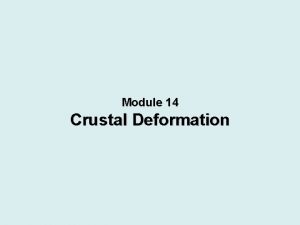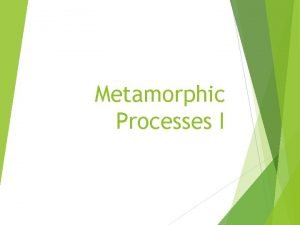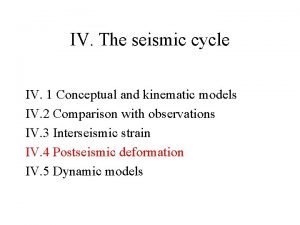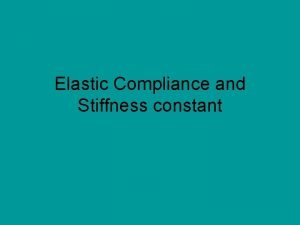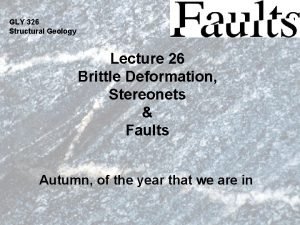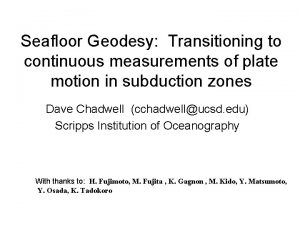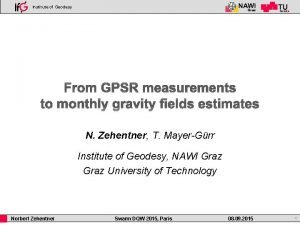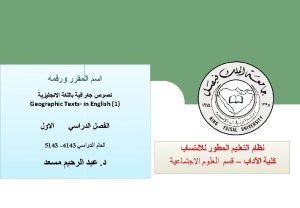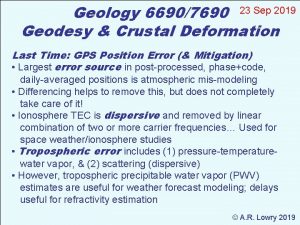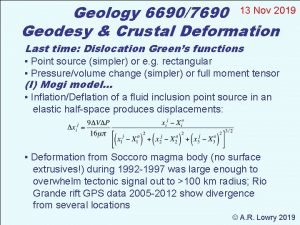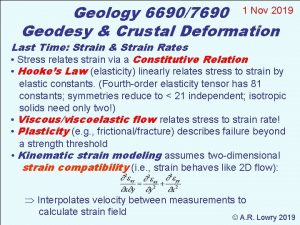Geology 66907690 18 Sep 2019 Geodesy Crustal Deformation







- Slides: 7

Geology 6690/7690 18 Sep 2019 Geodesy & Crustal Deformation GPS Positioning: Signals & Codes • GPS Signal Structure consists of three(+) codes superposed on two(+) signals (three on some satellites) • Receivers distinguish satellite transmissions from the microwave background by cross-correlating antenna reception with known PRN codes of the SV’s • Tectonic-Grade Applications track phase on carrier signals (L 1, L 2, eventually L 5 & L 4? ) and use the doppler to determine range change over time • Errors in estimates of satellite position, satellite clocks (& other common-mode errors) are reduced by differencing two or more receivers to each satellite • Double-differencing (two satellites, two receivers) ensures an integer ambiguity (= range at the first phase observation, when using doppler). © A. R. Lowry 2019

Read for Wed (25 Sep) Herring, T. A. , Melbourne, T. I. , Murray, M. H. , Floyd, M. A. , Szeliga, W. M. , King, R. W. , . . . & Wang, L. (2016). Plate Boundary Observatory and related networks: GPS data analysis methods and geodetic products. Reviews of Geophysics 54(4), 759 -808. Also read for Fri 20 Sep: Wahr § 3. 1 -3. 2 (67 -75)

Borehole Strainmeters (Station AVN 2, Oklahoma) Strainmeters are several orders of magnitude more sensitive than GPS, so they pick up everything. . . But they are also very challenging data sets to use and understand, because the directions of strain are rotated/ perturbed by local elastic and anelastic (fracture) heterogeneities in a way that is 3 D-wavenumber dependent. Most successful studies have used them for time-related (not direction-related) purposes. . .

GPS Error Sources (and Mitigation) Satellite position and SV clocks: Single Difference Correction • Real-time (Nav Message) orbit plus clock drift errors ~ 5 m A • Various orbit estimation centers B (e. g. , IGS, JPL) solve for satellite a b position, velocity, clocks and provide to users (error ~ 3 -6 cm) Double Difference Residual • Network positioning applications 1 2 remove these common mode errors by differencing A B • Precise point positioning does not difference; neglects these errors a – 2 a – 1 b + 2 b (yields integer ambiguity)

Atmosphere I. The Ionosphere: x’s are double-differenced positions using two frequencies; circles positioned using L 1 only. . . Differenced over < 5 km.

GPS Error Sources (and Mitigation) Atmosphere I. The Ionosphere: Is responsible for most • Uppermost layers of the atmosphere (~1 m) error in WAAScorrected single(30– 50 km altitude) are ionized by solar radiation • Has dispersive effect on microwave Refractive index n = c/v depends on frequency f as: n = 1 + c 2/f 2 + c 3/f 3 + c 4/f 4 + … • To first order can correct this by a linear combination of phase at two different frequencies: LC = L 1 – f 2 L 2/f 1 (the “ionosphere-free” linear combination!) frequency positions… Ideally use dual-freq… Potential for greater improvement using an additional frequency ( higher order correction!)

GPS Error Sources (and Mitigation) Atmosphere I. The Ionosphere: One person’s noise is another person’s signal… GAIM (developed here on campus) uses GPS measurements of Total Electron Content to model space weather in real-time.
